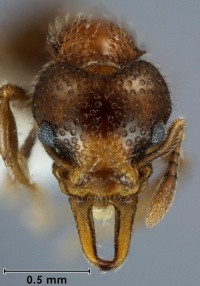Epopostruma avicula
| Epopostruma avicula | |
|---|---|

| |
| Scientific classification | |
| Kingdom: | Animalia |
| Phylum: | Arthropoda |
| Class: | Insecta |
| Order: | Hymenoptera |
| Family: | Formicidae |
| Subfamily: | Myrmicinae |
| Tribe: | Attini |
| Genus: | Epopostruma |
| Species: | E. avicula |
| Binomial name | |
| Epopostruma avicula Shattuck, 2000 | |
This species is known from a limited number of wet forested sites in south-east Australia.
Identification
The distinctly bicoloured gaster combined with the solid wing-like extensions on the postpetiole will allow separation of this species from close relatives.
Keys including this Species
Distribution
Latitudinal Distribution Pattern
Latitudinal Range: -34.68333054° to -38.48333°.
| North Temperate |
North Subtropical |
Tropical | South Subtropical |
South Temperate |
- Source: AntMaps
Distribution based on Regional Taxon Lists
Australasian Region: Australia (type locality).
Distribution based on AntMaps
Distribution based on AntWeb specimens
Check data from AntWeb
Countries Occupied
| Number of countries occupied by this species based on AntWiki Regional Taxon Lists. In general, fewer countries occupied indicates a narrower range, while more countries indicates a more widespread species. |

|
Estimated Abundance
| Relative abundance based on number of AntMaps records per species (this species within the purple bar). Fewer records (to the left) indicates a less abundant/encountered species while more records (to the right) indicates more abundant/encountered species. |

|
Biology
Castes
Nomenclature
The following information is derived from Barry Bolton's Online Catalogue of the Ants of the World.
- avicula. Epopostruma avicula Shattuck, in Bolton, 2000: 57, figs. 59, 71, 86 (w.) AUSTRALIA.
Type Material
- Holotype, worker, Flinders, Victoria, Australia, Lowery,B.B., ANIC32-015342, Australian National Insect Collection.
- Paratype, 2 workers, Flinders, Victoria, Australia, Lowery,B.B., ANIC32-003660, Australian National Insect Collection.
Unless otherwise noted the text for the remainder of this section is reported from the publication that includes the original description.
Description
In full face view the lateral margin of the head between the eye and the posterior corner with an indistinct angle. Pronotal spines present, distinct. Posterior section of metanotum in approximately the same plane as the dorsal face of propodeum, the junction of these plates a shallow depression, the dorsal face of the propodeum convex. Posterior face of propodeum between bases of spines and propodeal lobes with flanges. Petiolar spines varying from indistinct and essentially absent to short, indistinct angles. Anterior face of postpetiole shorter than the dorsal face and separated from it by a broadly rounded convexity; sides of postpetiole expanded laterally in the form of thin, solid wings, their outer margins flat or weakly convex; posterolateral margin of postpetiole (immediately anterior of gaster) flat to weakly convex. Dorsum of petiole, postpetiole and gaster with numerous elongate erect hairs, the majority of which are bend near their tips. First gastral tergite smooth; gaster immediately behind attachment with gaster with a very narrow band of short longitudinal rugae. Body colour yellow-red to brown with yellow-red mandibles and legs; dorsal surface of head slightly darker than body when body yellow-red, similar in colour to body when body brown, sometimes with a small infuscated spot in central region; gaster with anterior one-quarter to one-third yellow, contrasting with the dark red-brown posterior section.
Measurements
Holotype worker. TL 3.8mm, HL 0.82mm, HW 0.83mm, CI 101, MandL 0.42mm, MandI 51, SL 0.49mm, SI 59, PronW 0.52mm, ML 0.99mm.
References
- Shattuck, S. O. 2000. Genus Colobostruma. Genus Mesostruma. Genus Epopostruma. Pp. 31-67 in: Bolton, B. The ant tribe Dacetini. Mem. Am. Entomol. Inst. 65: 1-1028 (page 57, worker described)
References based on Global Ant Biodiversity Informatics
- Bolton, B. 2000. The Ant Tribe Dacetini. Memoirs of the American Entomological Institute 65


